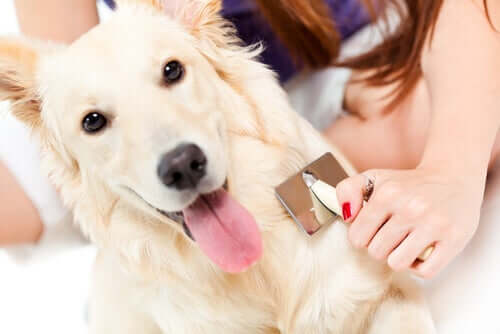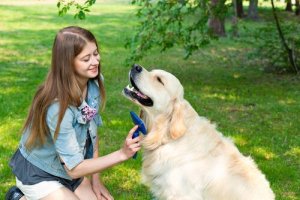5 Reasons You Should Brush Your Dog Regularly

Dynamic and ever-changing, skin is the largest organ in the body. Hair is one of the main structures of the skin, and is vital for our pets’ health, serving to protect the skin and regulate body temperature. So, if you want to keep them happy and healthy, it’s essential to brush your dog regularly.
The skin is made up of three distinct layers: epidermis, dermis and hypodermis. Every layer has a different thickness and is made up of different structures. Together, these three layers have a variety of functions:
- Protection against mechanical impacts, variations in temperature, micro-organisms, radiation – such as UV rays – and chemicals.
- The skin is the most sensitive organ in the body, containing thousands of different nerve receptors.
- It is involved in thermoregulation, helping to maintain a constant internal temperature.
- It also has a metabolic function, synthesizing Vitamin D or fat reserves in the form of triglycerides.
Looking after their coat is one of the best ways to keep your pet’s skin in great condition. Otherwise, you leave their skin vulnerable to a whole range of issues, which can, in turn, lead to more serious illnesses.
Brush more, wash less
Animals that have a thick coat of fur don’t need to be washed with soap and water as often as those that don’t. If you give your dog too many baths, you’ll remove the natural oils that protect their skin. This will only increase the chance of your pet developing conditions such as infections or dermatitis.

Brushing your dog, on the other hand, will remove most of the dirt that builds up on a daily basis without removing these protective oils. Dust, mites and other debris are easily removed with gentle daily brushing.
Reasons you should brush your dog
Brushing should be a pleasant and relaxing activity for your dog. If your dog doesn’t like being brushed, it’s important to try and make it a positive experience for them.
Start by showing them the brush while offering them one of their favorite treats. After a few days, you can gently brush them in an area where they enjoy being stroked, again making sure to give them plenty of treats.
Over time, you can slowly build on this. Increase the duration of your grooming sessions gradually, brushing different parts of their body, and reducing the number of treats. However, it’s important to respect the animal’s boundaries. Push them too far, and you may inadvertently turn simple grooming into a traumatic experience for your pet.
When grooming becomes a pleasant task for both dog and owner, it can be a great bonding activity, allowing you to strengthen your relationship with your pet. Your dog will feel less stressed, and love you even more.

Use this opportunity to check their skin
Grooming time is the perfect opportunity to get a closer look at your pet’s skin. As you brush, the hairs part, allowing you to see the skin more clearly.
Any wounds, changes in skin color, or thickening of the skin can easily go unnoticed beneath a thick coat. If you brush your dog regularly, you can catch any problems early on and make sure your pet gets the necessary treatment.
Brush your dog and prevent dermatitis
Whether long or short-haired, grooming is essential for any dog. Brushing your dog regularly will help to remove any dead hair, and allow air to reach the skin. This can help reduce the growth of anaerobic bacteria, which require an oxygen-poor environment to survive.
If you see any signs of dermatitis, it’s important to seek veterinary attention as soon as possible to prevent the problem from getting worse.
Regular brushing helps to deter parasites
While brushing your dog might not be the best way to keep your dog parasite-free, it can help to deter them.
It’s always good to brush your dog after a walk in the countryside, especially in the springtime. This will allow you to brush off any dirt, and check that they haven’t picked up any fleas or ticks.
We hope that this article has helped you to see the importance of brushing! Here’s another great article for you on a similar topic.
All cited sources were thoroughly reviewed by our team to ensure their quality, reliability, currency, and validity. The bibliography of this article was considered reliable and of academic or scientific accuracy.
- Castellanos, I., Clarena, G., Rodríguez, T., Iregui, C., & Arturo, C. (2005). Estructura histológica normal de la piel del perro (Estado del arte). Revista de medicina veterinaria, 1(10), 109-122.
- Giraud, E., & Hollin, G. (2016). Care, laboratory beagles and affective utopia. Theory, Culture & Society, 33(4), 27-49.
- Rooney, N., Gaines, S., & Hiby, E. (2009). A practitioner’s guide to working dog welfare. Journal of Veterinary Behavior, 4(3), 127-134.
